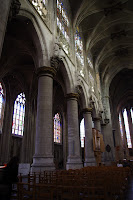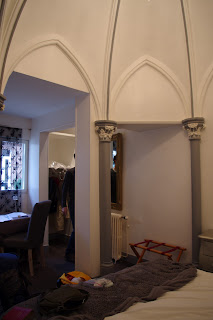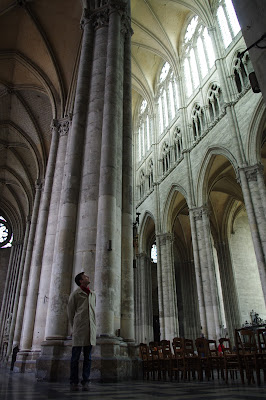 |
| Colorful houses in Rouen. |
As Lisa and I finished our contractually-obligated hours on April 5th and as Easter vacation began on April 6th, we decided to spend a week traveling across northeastern France to Brussels (where Lisa has a friend from Columbus) to Cologne to Paris (to meet our friend Chris from North Carolina, who was coming to France to visit us). This whirlwind trip included seven cities in seven days and our first stop was Rouen (pronounced "rwahn" - all one syllable), the capital of the region of Haute-Normandie, "the western Pennsylvania of France." For those of you scoring at home, this was the sixth of France's 21 mainland regions I've visited and Lisa's tenth.
 |
Monet's view of the
cathedral.
|
Getting to Rouen involved waking up insanely early, getting to downtown Rennes to take a 7:15 am bus, then riding for four hours. The reason we put ourselves through this misery was because it saved hundreds of euros over taking the train (which also involved going into Paris, changing train stations, then coming back to Rouen). The bus ride itself was fine, just long. We stopped at a rest area outside of Caen (about half-way through the trip) and once we had all re-boarded the bus, a group of French customs officers got on with a (very happy!) dog who sniffed his way up and down the aisles then the luggage compartments under the bus. We're not sure what they were looking for, but they didn't seem to find anything!
 |
Joan of Arc's tower.
|
Rouen is located on the Seine River about 80 miles downstream from Paris and is primarily notable for two things: its Cathedral (of which Monet did a series of 30 paintings, in different weather conditions, in the mid-1880s -
here's the Wikipedia entry with about half of the paintings) and as the places where Joan of Arc was imprisoned and also where she was burned at the stake as a heretic by the English in 1431. Jimmy and Jenny left us their Rick Steve's guidebook to France (thanks, guys!) and we used that to get us around for our seven hours or so in Rouen.
 |
Neapolitan nativity scene at the art museum--rather
flamboyant!
|
The bus dropped us off on one of the busy quais along the Seine and we hiked up from there into the central city to the art museum, ate our picnic lunch in the park out front, then went inside to take advantage of the free bag storage there (one of Rick Steve's tips!). The museum itself was surprisingly large and one of the better ones we'd been to up to that point - lots of Renaissance stuff, lots of French Baroque painting of the 17th century (which I don't really care for) and some good Impressionist paintings. The highlight was one of Monet's series of the Rouen Cathedral.
 |
Plague cemetery, complete with dried cat to watch over
the souls.
|
After the museum, we followed Rick Steve's suggested walking tour, but in reverse (since the art museum was his end point). We walked to the church of St. Maclou, which, unfortunately, was being restored so we couldn't see much of the exterior. Rather than try to go inside we found the nearby Aître St. Maclou, and old 16th-century graveyard for plague victims. The buildings around the courtyard are now an art school but the wooden walls are carved with skulls and grave-diggers' tools. Grisly, but cool, stuff.
 |
Detail from the plague cemetery.
|
 |
| Cathedral. |
We then walked to the main attraction, the Cathedral, mostly built in the 13th century but with much of the exterior built in the 16th century. There, too, restoration work was being on the façade so we couldn't see the whole thing. When we thought about these two churches along with the fact that the interior at Chartres is currently undergoing restoration, we almost wished we were here two or three years in the future when all this work would be done! Inside, a service for the Stations of the Cross was being held (it
was Good Friday, after all) so we couldn't see much there, either.
 |
The men of Rouen cathedral's facade, hanging out inside
for cleaning. Everybody needs a bath sometimes, right? |
 |
Cathedral interior.
|
 |
Rue du gros horloge.
|
We went across the street to the tourist office, got our free map and a couple small souvenirs, then walked up the street to the Gros Horloge, a 16th-century civic clock tower built over the street, passing the Gothic Palais de Justice on the way. At this point, we decided to return to the Cathedral for the last 45 minutes or so of the Stations of the Cross. I had never been to one before - and certainly never to one in French! (I managed to understand a decent amount, though.) At the end of the service, everyone followed the cross into the choir of the church for the last couple stations and it was quite a crowd.
 |
Crack in the ceiling where the
spire came crashing down
during the tornado of 1999.
|
Following the service, we walked around the cathedral and saw the tomb of Rollo, the first duke of Normandy (he was a 10th-century Viking lord to whom the King of France gave Normandy as a possession) and the tomb where Richard the Lion-Hearted of England's heart is buried. They also had an interesting little display about the freak 1999 day-after-Christmas cyclone that sent the Cathedral's 26-ton spire crashing hundreds of feet through the roof to the floor of the choir below. We also got to see some of the statues of the façade that had been moved inside and to appreciate just how large they are. All in all, it was a cool church and slightly different in style from some of the other Gothic cathedrals we've seen so far.
 |
Palais de Justice, old home of the Parlement de
Normandie.
|
 |
A Rouen wedding cake--a
rainbow-striped macaroon tower! |
We then walked back to the big clock tower and stopped in a (very crowded) candy store, "The Tears of Joan of Arc," for a snack of macarons and then on to the old market where Joan of Arc was burned, passing a surprising number of panhandlers on the way. By this point, it was getting late and we needed to get back to the museum before they closed to collect our bags. We did, then walked up the street to the train station (passing the tower where Joan of Arc
may have been imprisoned before her execution) and bought our tickets for the 6:30 train to our next destination: Amiens.
Bonus pictures:
 |
| Lisa, showing the scale of the women. |
 |
Aaron, showing the scale of Aaron.
|




























































